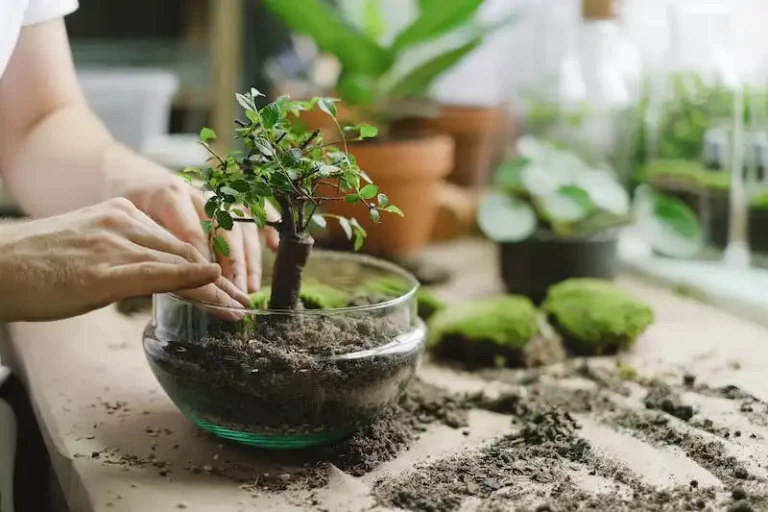Trimming your tree is an important part of maintaining its health and appearance. By removing dead or damaged limbs, you can promote new growth and prevent further damage to the tree. Trimming a tree can be done by yourself or with the help of a professional. In this article, we will guide you through the process of trimming a tree, regardless of whether you choose to do it yourself or hire someone.
When it comes to trimming a tree, there are several tools you can use. One of the most common tools is a tree pruner, which allows you to reach high branches without having to use a ladder. Another tool you can use is a tree limb cutter, which is designed to minimize cracks and damage to the tree when cutting off large limbs. Depending on the size of the tree and the branches you need to trim, you may also need a ladder or an extendable pole saw.
Before you begin trimming your tree, it is important to assess the tree’s health and any potential risks. If you are unsure about whether or not to trim a certain branch, it is best to call a professional for their expert opinion. They will be able to assess the tree’s health and stability and recommend the best course of action.
When trimming a tree, it is important to follow the right technique to minimize damage and promote new growth. Start by trimming smaller, weaker branches and work your way up to larger ones. Be sure to make clean cuts at the right position to avoid any damage. If you are using a ladder or an extendable pole saw, make sure you are in a safe and stable position and always pay attention to your surroundings.
Whether you choose to trim your tree by yourself or hire a professional, always keep safety in mind. Make sure you have the proper equipment and knowledge to trim the tree efficiently and without causing harm to yourself or the tree. If you are unsure about any step of the process, do not hesitate to cancel the task and seek professional help.
Trimming a tree is an essential part of maintaining its health and appearance. By following the proper techniques and using the right tools, you can keep your tree in optimal condition and enhance the beauty of your garden. Remember to regularly inspect your tree for any signs of damage or disease and take action when necessary. With a little attention and care, your tree will thrive for years to come.
DIY – How to Trim Tree Branches Yourself
Trimming tree branches can be a daunting task, but with the right tools and techniques, you can do it yourself. Instead of hiring professionals, you can save money and take pride in maintaining your own trees. Here’s a step-by-step guide on how to trim tree branches yourself:
Step 1: Assess the tree
Before you start trimming, take a close look at the tree and assess which branches need to be trimmed. Avoid cutting off large branches as it can damage the tree and affect its overall health and stability. Instead, focus on smaller, dead or weak branches that are close to the ground or rubbing against each other.
Step 2: Use the right tools
Invest in a good pair of pruning shears or a telescopic tree trimmer. These tools have long handles, allowing you to reach higher branches without climbing the tree and risking injury. The telescopic feature of the trimmer also makes it easier to assess and trim branches at various heights.
Step 3: Trim with caution
When trimming, make clean and precise cuts. Improper cuts can leave the tree vulnerable to disease and pests. Use the pruning shears or telescopic trimmer to make a cut at a 45-degree angle, just above the branch collar. This will promote proper healing and reduce the risk of infection.
Step 4: Safety first
Always prioritize safety when trimming tree branches yourself. If the branches are too high to reach safely, consider using a ladder or renting ropes and climbing equipment. Wear protective gear such as goggles, gloves, and a helmet to reduce the risk of injury. If the job seems too big or dangerous, it’s best to hire a professional.
Step 5: Clean up
After trimming, make sure to clean up the fallen branches and debris. Dispose of them properly or use them as mulch in your garden. Keeping the area around the tree clear will prevent accidents and promote the tree’s healthy growth.
In conclusion, trimming tree branches yourself can be a rewarding DIY project. By following the right steps and using the appropriate tools, you can maintain the health and appearance of your trees and save money in the process. Just remember to prioritize safety and consider hiring professionals when dealing with larger or more complicated trees.
When DIY Tree Trimming is OK and When It’s Not
Trimming tree limbs is an essential part of tree maintenance. It helps maintain the health and appearance of the tree, keeping it safe and preventing any potential hazards. While tree trimming can be a great DIY project, it is important to know when it is safe to do it yourself and when it is best to call a professional.
Before you grab your tools and start cutting, there are a few things you should check. First, assess the size of the tree limbs you need to trim. If they are small and easily accessible, you can handle the job yourself. However, if the limbs are large and require a ladder or telescopic lift to reach, it is best to call a professional for help.
Next, consider your own safety. Tree trimming often involves climbing and using sharp tools, so it is important to stay safe. If you are not comfortable climbing or handling tools like a hand cutter or saw, it is best to call a professional who has the necessary training and experience.
Another important factor to consider is the health of the tree. If the tree is showing signs of distress, such as dying branches or fungi, it is best to call a professional arborist who can assess the tree’s health and recommend the appropriate trimming or pruning methods.
For DIY tree trimming, it is important to have the right tools. A good pair of pruning scissors or a hand cutter is usually sufficient for trimming small branches. For larger trees, you may need a telescopic lift or a pruning saw. Make sure your tools are sharp and in good condition before starting the job.
When using a ladder or climbing equipment, always follow safety guidelines. Make sure the ladder is stable and secure, and never climb higher than the fourth rung from the top. If you are using ropes or wires to support yourself while climbing, check that they are strong and in good condition.
While DIY tree trimming can save you money, there are situations when it is best to call a professional. If the tree is located near power lines, it is important to stay away and call an electric company or a professional arborist experienced in dealing with such situations.
Trimming trees close to your home or other structures should also be left to the professionals. It requires careful planning and expertise to ensure the branches are cut in a way that prevents any damage to property.
In conclusion, DIY tree trimming can be a great way to maintain the health and appearance of your trees. However, it is important to know your limits and when it is best to call a professional. Assess the size of the limbs, consider your own safety, and evaluate the tree’s health before making a decision. Remember, the importance of safety and the well-being of your trees should always come first.
How to trim small tree branches yourself
If you have small tree branches that are reaching into unwanted areas or that are diseased, it is important to trim them properly to maintain the health and aesthetics of your garden. Trimming small tree branches yourself can be done with the right tools and techniques, allowing you to save money and take pride in doing the task yourself.
First, you will need to inspect the tree branches that need trimming, including those that are crossing or growing too close to other branches. Look for any signs of disease or deadwood, as these branches should be removed for the overall health of the tree.
Next, make sure you have the right tools for the job. A small hand-held pruner or a pair of pruning scissors can be used for smaller branches up to about 1/2 inch in diameter, while loppers or a pruning saw may be necessary for thicker branches. Always ensure that your tools are sharp and in good condition to make clean cuts and prevent damage to the tree.
Before you start trimming, consider the optimal time to do so. Winter is usually the best time, as the tree is dormant and there is less risk of insects or disease affecting the freshly cut branches. However, if you notice any diseased or damaged branches during the growing season, it is important to remove them immediately to prevent further spread.
When you start trimming, be mindful of safety. Never climb a ladder or use a chainsaw without proper training and safety equipment. If the branches are too high to reach with a ladder, it may be best to call a professional tree trimmer for assistance.
Start by making small cuts on the undersides of the branches, about 6-12 inches away from the trunk. This will prevent the weight of the branch from damaging the tree as it falls. Then, make a third cut just outside of the branch collar, which is the swollen area where the branch connects to the trunk.
It is important to pay attention to the angles of the cuts, as well as the overall shape of the tree. Try to maintain the natural form of the tree and avoid removing too much foliage, as this can stress the tree and affect its growth. Step back frequently to assess your progress and make any necessary adjustments.
After trimming, it is a good idea to clean your tools with a disinfectant to prevent the spread of disease. Dispose of the trimmed branches in a compost pile or yard waste bin, or use them as firewood if they are thick enough.
In summary, trimming small tree branches yourself can be a rewarding task if done properly and safely. By following these steps and paying attention to the health and aesthetics of the tree, you can ensure that your garden remains beautiful and well-maintained.
How to trim a small tree
Trimming a small tree requires proper attention and the right tools to prevent damage to both the tree and yourself. Here are some tips on how to effectively trim a small tree:
- Before you start trimming, make sure to check the area around the tree for any obstacles or hazards. It’s important to create a safe environment for yourself and others.
- Use a pair of loppers to trim smaller branches that are about 2 inches or less in diameter. These are thin, long-handled pruners that make it easy to reach high branches without needing a ladder.
- If the branches are thicker, use a handsaw or a pruning saw to trim them. These tools will require more effort, so be sure to pay attention to your technique and stay safe.
- When using a ladder or climbing a tree to reach higher branches, it’s crucial to have someone with you to hold the ladder or assist you. Safety should always be your top priority.
- If you need to trim branches that are out of reach, consider using a telescopic pole pruner. This tool allows you to extend its reach to prune higher limbs without the need for climbing or using a ladder.
- The 3-cut method is a recommended technique for pruning larger branches. This involves making an undercut about 12 to 18 inches away from the main branch, then making a second cut slightly closer to the trunk. Finally, make a third cut to remove the remaining stub, being careful not to damage the main branch.
- To prevent the spread of diseases and pests, clean your cutting tools with disinfectant before and after use. This will help keep your small tree healthy.
- If you’re not confident in your abilities or if the tree is too large to handle, it’s always best to hire a professional tree trimmer. They have the expertise and equipment to efficiently trim the tree while ensuring optimal results.
Remember, trimming a small tree requires caution and proper technique. By following these tips, you’ll be able to keep your small tree well-maintained and enhance its overall health and appearance.




